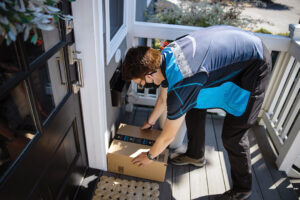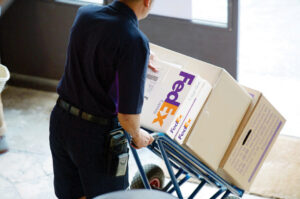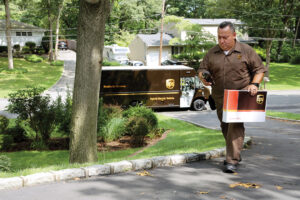Porch Pirates
11/2/2022
Nathan Peterson had several packages swiped from his front door within the span of a few months. Photo submitted
Protecting packages from theft in the age of online shopping
When Nathan Peterson ordered a $100 Apple HomePod speaker and was notified it had been delivered to his apartment, he returned home to find the package missing.
Best Buy sent him a replacement. It was stolen again.
In total, Peterson had four packages stolen within a few months.
“I should have learned after the first time,” he said.
Peterson has lived in the Des Moines area his entire life but is attending college in Emmetsburg, a town with fewer than 4,000 people.
“Being in a small town, you wouldn’t expect people to go around stealing packages like in a larger city,” Peterson said.
Now, he has his packages shipped elsewhere and picks them up later: either to his parents’ house or at school, where people are usually present to receive the delivery. He still doesn’t have a HomePod.
“I gave up trying to buy one,” he said.
Alternate delivery locations, locked parcel boxes, doorbell cameras, and good old neighborly assistance — these are just some of the many tactics consumers employ to foil would-be porch pirates.

Retailers like Amazon often refund customers for stolen or lost packages, causing package theft to be underreported. Photo courtesy of Amazon
By the numbers
Across the United States, 64.1% of the population has fallen victim to package theft in the last 12 months, security experts at SafeWise reported in a recent survey. That equates to an estimated 210 million stolen packages in one year.
And while larger U.S. cities like Denver, San Francisco and Salt Lake City rank highest in package theft risk, even Iowa’s communities aren’t immune to porch piracy — especially within the last three years.
“Since COVID and the online industry just exploding, and people who never used to shop online before now shopping online regularly, the incidence of these thefts has increased, just because there’s more opportunity for the thief,” said Sgt. Paul Parizek of the Des Moines Police Department. “So we try to push the awareness year-round.”
The City of Des Moines couldn’t provide statistics on package theft, but its largest suburb did. In 2019, West Des Moines received two reports of package theft, valued at approximately $85 total. Then, the city saw nine cases in 2020 and 16 cases in 2021 — about $4,000 of stolen property each year.
For perspective, West Des Moines had 1,397 overall thefts reported in 2019, with 970 in 2020 and 1,111 in 2021. And while Des Moines couldn’t provide specific case numbers for package theft, they did for overall theft and burglaries: 8,000-plus cases in 2021, and more than 5,500 in 2022 so far.
In West Des Moines, only one case of package theft has been solved in the last three years.
“Porch pirate package thefts are a very small percentage of the amount of thefts we receive a year,” said Sgt. Jason Heintz. “They are also difficult to solve and, a lot of times, lack evidence to make an arrest.”
Few other Des Moines suburbs had available data. However, Ankeny police reported 31 cases of package theft in 2021 and 17 in 2022 through October. Urbandale had 15 cases in 2021, with 10 this year so far.
Because many retailers are quick to offer refunds to customers, package theft is often viewed as an underreported crime. Even Heintz said he was surprised when pulling porch piracy data for West Des Moines.
“I actually expected the numbers to be a little bit higher than what they are, just based on how much I do think it occurs and how much you do see it on a national level, making different news outlets, too,” he said.
While it may be more convenient to pursue a refund for stolen deliveries than file a police report, Heintz encouraged residents to report all incidents of package theft. More data enables police to visualize neighborhood trends, focus surveillance efforts and move investigations forward.
Does the punishment fit the crime?
For Iowan porch pirates, the severity of the crime largely depends on the contents of the package — ironic, given that many package thieves are stealing blindly.
“The worst part about these crimes is that they don’t know what they’re taking,” Parizek said. “They see a package and they take it off your step, and they don’t know if it’s expensive electronics or shoes for your kid. So the impact on families is sometimes much greater than the misdemeanor crime itself would indicate.”
Under Iowa code, degrees of theft are broken into dollar amounts of stolen property value:
$10,000 and up: First degree theft, class “C” felony
$1,500 to $10,000: Second degree theft, class “D” felony
$750 to $1,500: Third degree theft, aggravated misdemeanor
$300 to $750: Fourth degree theft, serious misdemeanor
Up to $300: Fifth degree theft, simple misdemeanor
The majority of package thefts classify as a relatively minor offense, but degrees of theft are also affected by criminal history. Burglary charges could also be thrown into the mix, depending on how the culprit enters the property.

Lantz Sakris resides in Johnston and had a PlayStation stolen from the box sometime before delivery. Photo submitted
Theft before the porch
What about pre-porch-piracy: packages stolen before delivery?
Johnston resident Lantz Sakris ordered a PlayStation 5 from Walmart earlier this fall. He was at work when FedEx delivered it, but he asked his mother to wait at his house and sign for the package.
Over his lunch break, he went home and noticed the package was suspiciously light. When he opened it, the box was empty.
“I turned the box over, and you could see where somebody had cut open the Walmart tape, and then put clear tape over it,” Sakris said. “They basically cut the bottom out, pulled the PlayStation out of the bottom of the box, and just retaped it over. So, somewhere between Walmart and FedEx, it got stolen.”
Because Sakris’ mother had already signed for the package, Walmart deferred him to FedEx. The carrier company told him they’d “look into it” and called him back the next day, saying they found nothing.
Sakris was frustrated at the lack of concern from both the vendor and shipper.
“You would think somewhere along the line, they’d be like, ‘Hey, this package changed in weight by 15, 20 pounds,’ or the FedEx guy would realize, like, ‘Why does this feel so light?’ ”
Sakris’ last resort was to dispute the charge with his credit card company. He is still waiting to hear back, but otherwise, he’ll have lost upwards of $600.
In the meantime, Sakris ordered a replacement PlayStation 5, this time having it delivered to a separate facility where he could pick up the package in person.
“I’m out 600 bucks because my mom signed for a package not knowing what it should weigh,” he said. “That seems kind of jacked up.”
Who’s responsible?
CITYVIEW inquired with several commercial package carriers about how they handle package theft, including before delivery, and we received carefully crafted responses.
“All year long we work with our drivers and service providers to be aware of their surroundings and report any unusual activities,” said FedEx spokesperson Shannon Davis, adding: “Any customer who suspects that a package has been stolen should contact police.”
United Parcel Service (UPS) representative Kelly Davenport gave CITYVIEW a statement along the same lines.
“Our UPS drivers are taught to be aware of their surroundings and to report anything they consider unsafe to the police and to their local management team,” Davenport wrote. “We work with local law enforcement across the country to stay abreast of crime in specific areas and take appropriate measures if criminal activity becomes a concern.”
Amazon packages account for more than 50% of porch piracy cases, according to SafeWise. Several representatives from the e-commerce giant didn’t respond to CITYVIEW’s requests for comment.
Although reticent on the topic of package theft response, commercial carriers were quick to highlight their package theft prevention capabilities. Customers can utilize options to provide specific delivery instructions for drivers, hold packages, or redirect delivery to retail locations, their workplace or neighbors.
A few decades ago, real-time package tracking was virtually nonexistent. Today, many major carriers even send customers photos of their delivered parcel. Those with smart garages can provide access to Amazon drivers without sharing a code or physically opening the door.
Still, overall, the responsibility for stolen packages — and covering their cost — lies largely in the hands of the consumers and vendors.
“If UPS has completed the delivery, which includes driver-released deliveries to residences, UPS is not automatically responsible to reimburse the cost of the shipment,” Davenport said.
If enough thefts are reported in an area, UPS may put a restriction on that address so that signatures are always required to complete a delivery. It’ll show up as a “NO DR” on the driver’s device: no driver release.

Commercial carriers work with customers, vendors and police in the event of package theft. Photo courtesy of FedEx
A driver’s perspective
Speaking of — what’s it like for the delivery driver? As challenging as it was to find information from corporate, we were able to find a local UPS driver who agreed to speak with CITYVIEW anonymously.
This driver has been working in the field for seven years, typically handling 400 packages within an eight-hour shift. In his seven years, he said he’s never witnessed a theft and only averages one or two reports of theft among his delivered packages each year — pretty impressive, considering he delivers upwards of 100,000 packages annually.
Still, not all UPS drivers have such a clean record. If a customer files a stolen package claim, the driver is required to make three attempts to contact the person.
“Once it’s established that, yes, the package is not anywhere to be found, then they complete the claim,” the driver shared. “We have to hang some sort of tag at the door that says there’s going to be a police investigation and all this stuff.”
At the year’s end, a list is posted of all UPS drivers who have had packages go missing. For those who have lost one too many parcels, an investigation and disciplinary action follows.
“They can actually start garnishing your wages, but I’ve never seen that,” the driver said. “You’d have to have a lot of expensive stuff stolen before going through that disciplinary process.”
Theft response is a small part of drivers’ job — they’re simply instructed to contact management if they witness anything out of the ordinary — but theft prevention is heavily emphasized.
“They hammer into us every single Christmas to be aware of porch pirates because it’s an issue every single year during the holidays,” the driver said. He can usually tell when people are suspiciously following his truck, and in those situations, he said he makes sure to drop the package in a place that’s very difficult to find. Side doors, back patios, an open garage — he’s even heard of other drivers leaving parcels inside grills.
“Another thing they drill into us is to make sure we always ring the doorbell or knock,” he said.
If a customer doesn’t plan to be home during delivery, he said, the best thing they can do is to leave delivery instructions for their driver. They can even share their garage code with UPS. It’ll show up on the driver’s board device, called the DIAD (Delivery Information Acquisition Device). Fun fact: UPS revolutionized the delivery industry when it invented the first DIAD in 1990.
Still, no matter how much care is taken during delivery, the occasional theft is inevitable.
“It’s just part of the system that this sort of thing does happen,” the driver said. “They [UPS] just make it seem like we’re looking out for the customer.”

UPS delivery drivers are trained to contact management or police if they witness suspicious activity on the job. © 2022 United Parcel Service of America, Inc. All rights
What is to be done?
As much as package carriers may train their delivery drivers against theft, ultimately, the customer is responsible. Fortunately, ever-evolving technology has made it easier not only to prevent theft, but to solve ongoing cases.
“With the prevalence of home video systems and social media, we’re able to capture a lot more of these thieves now than we ever have been before,” said DMPD’s Parizek.
The city’s community camera program, WatchDSM, takes advantage of this. Through the program, residents and business owners register their security camera systems with DMPD. The city doesn’t have remote access to camera feeds and won’t access feeds without permission; however, they are able to easily pinpoint and contact registered owners if they need to review footage.
In cases of severe and repeated porch piracy, some police departments in the U.S. have utilized “bait” packages, rigged with GPS trackers to catch the thief. An intriguing prospect, but, Parizek said, probably not in the near future for Des Moines.
Instead, local police departments encourage residents to take proactive steps to deter package theft and convince those pirates to sail right past your porch. Be smart, be alert — and help your neighbors.
“The core of our community are good-hearted people who want to do the right thing and don’t want to see anybody victimized,” Parizek said. “If they know something, they tend to want to help out. And, in these cases, we don’t dangle a lot of reward money out there. People just do the right thing.” ♦
Tips for theft prevention:
- Track your shipment and be aware of expected delivery times.
- Take advantage of delivery notifications.
- Request items be shipped in a nondescript box, not the original product packaging.
- Schedule deliveries for when somebody is home.
- Utilize delivery instructions, and be specific: ask your driver to leave packages at side or back doors, behind a fence, or inside your garage.
- Invest in a locked parcel drop box.
- Minimize time packages are left sitting unattended by front doors.
- Get to know your neighbors. Ask them to bring your packages inside if you aren’t home to receive the delivery.
- Opt for signature release.
- Install a doorbell or peephole camera and use motion sensors if available.
- If you do have a home security system, make its presence clear. Post warning signs.
- Have packages shipped to alternate locations and pick them up later: your workplace, apartment complex offices, or various locations offered by delivery companies.

















